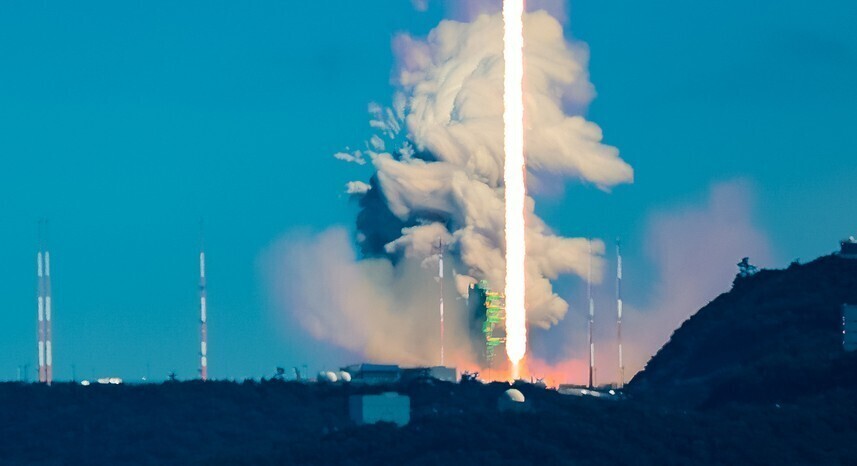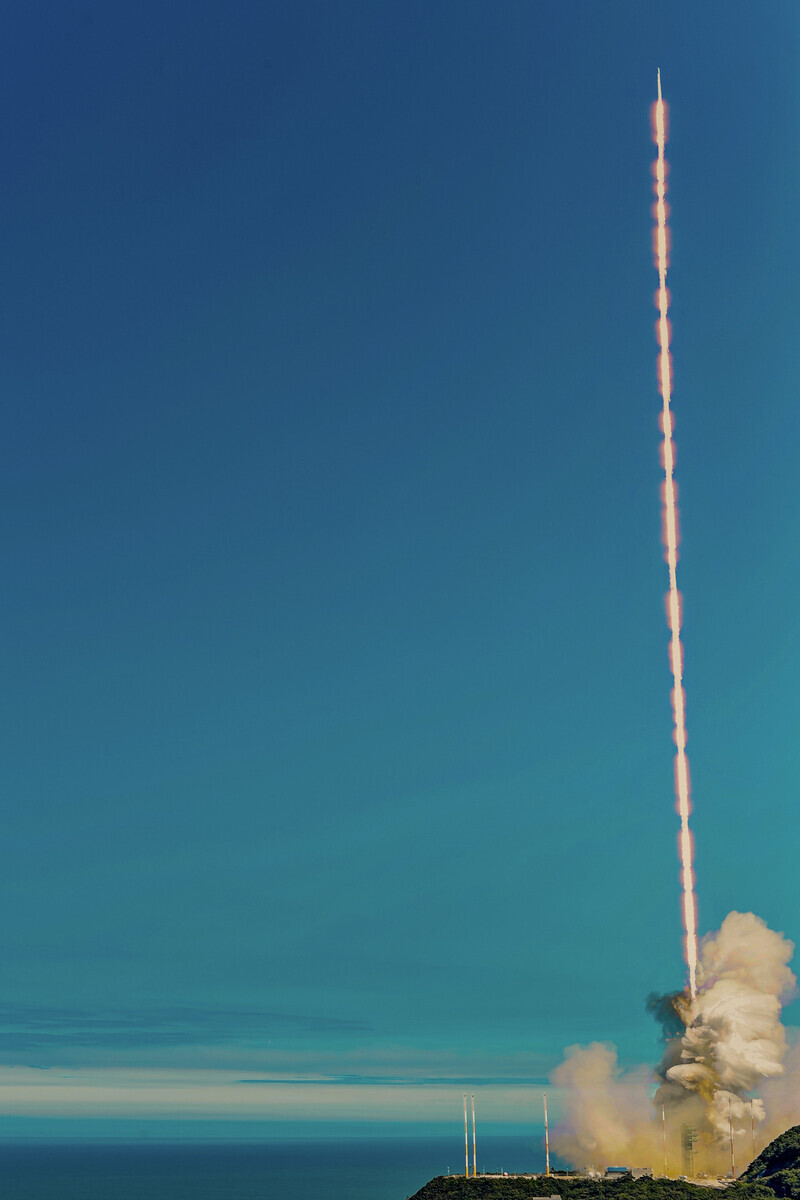hankyoreh
Links to other country sites 다른 나라 사이트 링크
Successful Nuri launch writes new history of S. Korea in space

Nuri, a space launch vehicle made exclusively with South Korean technology, successfully delivered its payload into its intended orbit after launch on Tuesday. With this feat, South Korea has become the seventh country in the world capable of placing a satellite for practical use into orbit using solely domestically developed technology.
Minister of Science and ICT Lee Jong-ho gave a briefing at 5:10 pm on Wednesday from the Naro Space Center’s press room where he announced that “the Korean space launch vehicle Nuri had a successful flight of 16 minutes and 7 seconds after lifting off from launch pad No. 2 at Naro Space Center at 4 pm. It completed its mission of placing a performance verification satellite and a dummy satellite into orbit at an altitude of 700 kilometers at a velocity of 7.5 kilometers per second within 14 minutes 57 seconds (897 seconds) and 16 minutes 7 seconds (967 seconds), respectively, of liftoff.”
Tuesday’s successful launch has illustrated South Korea’s capability of placing a satellite for practical use weighing 1,000 kilograms or more into orbit using independently developed technology.
The successful second launch of the South Korean homegrown launch vehicle on Tuesday is a significant occasion representing the culmination of three decades of local aerospace research and development since the early 1990s.
It also provides a milestone as South Korea gears up to prepare for even greater progress over the next 30 years.
Many experts are now saying the history of South Korean aerospace development will now be divided into the “pre- and post-Nuri” eras. They also agreed that with Nuri’s successful launch after two attempts, now is the right time to be preparing for the next 30 years, as well as a time for considering new systems and policies to respond to the “new space” trend of commercial spaceflight in global aerospace development.
The first factor that makes the Nuri rocket’s success so meaningful is that South Korea acquired its own technology through the launch vehicle’s cycle from design to production, testing, launch, and operation.
Naro, which was successfully launched on Jan. 30, 2013, was a single-stage rocket purchased from Russia. It was also only capable of carrying a small satellite weighing 100 kilograms. In contrast, the satellite that Nuri carried to an altitude of 700 kilometers was 15 times heavier at 1,500 kilograms.
Aerospace technology is difficult to develop independently and cannot be imported. This is why the first launch of Naro in 2009 was able to inaugurate a project of South Korean launch vehicle development at a cost of 2 trillion won — even though it was unable to achieve normal flight due to a fairing separation malfunction.
With the successful launch of Nuri, South Korea becomes the 10th country in the world to launch a rocket with its own independent aerospace strategic technology. It also developed a 75-ton liquid engine that made it the seventh country to possess a medium-large liquid rocket engine.

While South Korea entered the game later than the advanced space powers that have established competitiveness through their aerospace technology developed in the 1950s and 1960s, it has been steadily improving its technological capabilities since first developing the single-stage solid propellant sounding rocket KSR-I in 1993.
From there, it successfully launched the Naro rocket with 140 tons of thrust in 2013, and the Nuri rocket with 300 tons of thrust eight years later. With the advanced space powers taking around seven years on average to develop a 300-ton launch vehicle, this illustrated South Korea’s technological competitiveness to be on par with them.
In addition to the major powers, a few other countries have also attempted to develop space launch vehicles, including Pakistan. So far, South Korea is the only one to succeed.
To further improve the launch vehicle technology demonstrated with Nuri’s launch, the South Korean government plans to invest 680 billion won over the next six years in an advancement project that includes four additional Nuri launches.
“The successful second launch of Nuri brings a successful end to a South Korean launch vehicle development project that has lasted 14 years, but the significance of that project will reach its culmination when we have established Nuri’s reliability through repeated launches,” explained Jang Young-soon, director of the launcher system development team at the Korea Aerospace Research Institute.
By Lee Keun-young, senior staff writer
Please direct questions or comments to [english@hani.co.kr]
Editorial・opinion
![[Column] Has Korea, too, crossed the Rubicon on China? [Column] Has Korea, too, crossed the Rubicon on China?](https://flexible.img.hani.co.kr/flexible/normal/500/300/imgdb/original/2024/0419/9317135153409185.jpg) [Column] Has Korea, too, crossed the Rubicon on China?
[Column] Has Korea, too, crossed the Rubicon on China?![[Correspondent’s column] In Japan’s alliance with US, echoes of its past alliances with UK [Correspondent’s column] In Japan’s alliance with US, echoes of its past alliances with UK](https://flexible.img.hani.co.kr/flexible/normal/500/300/imgdb/original/2024/0419/2317135166563519.jpg) [Correspondent’s column] In Japan’s alliance with US, echoes of its past alliances with UK
[Correspondent’s column] In Japan’s alliance with US, echoes of its past alliances with UK- [Editorial] Does Yoon think the Korean public is wrong?
- [Editorial] As it bolsters its alliance with US, Japan must be accountable for past
- [Guest essay] Amending the Constitution is Yoon’s key to leaving office in public’s good graces
- [Editorial] 10 years on, lessons of Sewol tragedy must never be forgotten
- [Column] A death blow to Korea’s prosecutor politics
- [Correspondent’s column] The US and the end of Japanese pacifism
- [Guest essay] How Korea turned its trainee doctors into monsters
- [Guest essay] As someone who helped forge Seoul-Moscow ties, their status today troubles me
Most viewed articles
- 1[Column] The clock is ticking for Korea’s first lady
- 2Samsung barricades office as unionized workers strike for better conditions
- 3After 2 months of delayed, denied medical care, Koreans worry worst may be yet to come
- 4[Correspondent’s column] In Japan’s alliance with US, echoes of its past alliances with UK
- 5[Column] Has Korea, too, crossed the Rubicon on China?
- 6Hong Se-hwa, voice for tolerance whose memoir of exile touched a chord, dies at 76
- 7[Photo] Smile ambassador, you’re on camera
- 8All eyes on Xiaomi after it pulls off EV that Apple couldn’t
- 9[Guest essay] How Korea turned its trainee doctors into monsters
- 10US overtakes China as Korea’s top export market, prompting trade sanction jitters